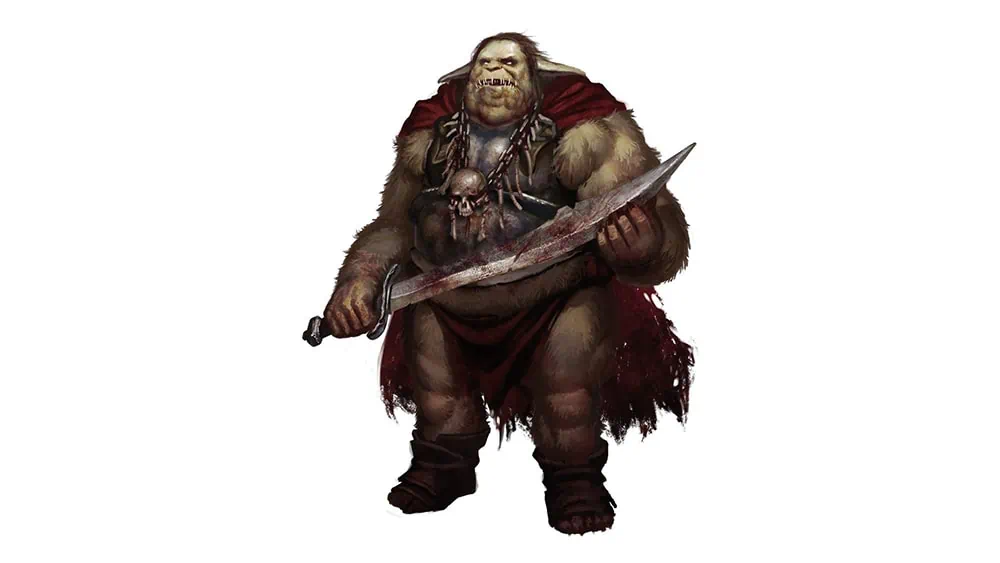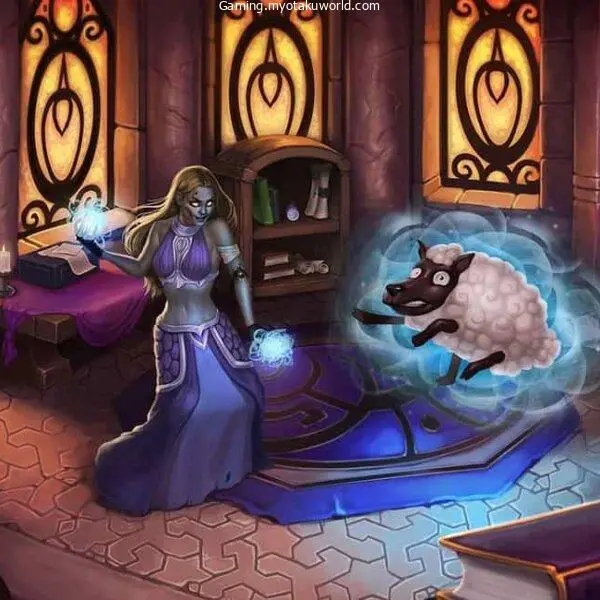The staff moved out of the way as the great detective and the bard from the College of Lore entered the library of the baron who had just died. The tiefling told his friends to clear the room and stop anyone from coming in.
When the baron’s servants and guards saw the tiefling’s devilish horns, they knew better than to challenge this great detective who was respected on many different planes of existence across the universe.
Once the strangers were gone, the tiefling detective lit his oily briar pipe and looked at the body with a careless air. The baron was lying on the carpet with his back stuck with a knife.
The Asmodeus tiefling looked at the body and the rest of the crime scene by using his Investigation and Arcana skills.
After thinking about things for a while, the Asmodeus tiefling took out his pipe and took off his kobza.
As soon as his wicked fingers touched the strings of his Cossack instrument, he started to sing in Infernal, the language of the Nine Hells.
“When the dead are told to speak,
It doesn’t matter if they’re cold.
What they did as kids doesn’t matter.
If I ask them, they tell me the truth.”
After his poem, he changed to the Common tongue so he could talk to the baron’s dead body. Welcome to a guide for Speak with the Dead 5e.
Bottomline on Speak With Dead
With Speak With Dead, you can ask a dead person up to 5 questions. With this spell, you can ask a nearby body up to five questions. The spell won’t work if any of the following things happen:
- The corpse was the target of this spell within the past 10 days
- The corpse no longer has a mouth
- The corpse is Undead
As per the Player’s Handbook (PHB) p. 277, the answers to these questions are usually “brief, cryptic, or repetitive” and subject to certain conditions:
- Questions must be in a language the corpse knew in life
- Answers are based only on what the corpse knew in life up to the time of its death
- If the corpse recognizes you as hostile or an enemy, it does not have to answer truthfully
- Corpse cannot make guesses about future events
You should also note that only the animating spirit is returned to the corpse, not the creature’s actual soul. Here are the spell’s stats:
Speak With Dead
- 3rd level Necromancy Spell
- Casting time: 1 action
- Range: 10 feet
- Components: V, S, M (burning incense)
- Duration: 10 minutes
Who Can Use Speak With Dead?
This spell is available to bards and clerics as per PHB.
Is Speak With Dead Good?
Yes. Speak With Dead is great both for problem-solving and for enjoyable role-play. Having this spell in the game adds texture to the storytelling.
Speak With Dead Caster: Character Build

So you know what’s going on, I’ll give you a character who can use the Speak With Dead Spell. In this case, I’ll use a male tiefling bard from the College of Lore who is 6th level and give him the name Crossroads.
If you have both a cleric and a bard in your party, I think the bard should choose Speak With Dead so that the cleric can focus on healing and spells that hurt zombies.
Speak With Dead is also great for College of Lore bards like Crossroads, who have a lot of skills and are therefore the best investigators.
Basic Stats
| Ability | Strength | Intelligence | Wisdom | Dexterity | Constitution | Charisma |
| Standard Sequence | 15 | 14 | 13 | 12 | 10 | 8 |
| Customized Sequence | 8 | 15 | 10 | 13 | 12 | 14 |
| Racial ASI | +1 | +2 | ||||
| 4th Lvl. ASI | +2 | |||||
| Ability Scores Total | 8 | 16 | 10 | 13 | 12 | 18 |
| Ability Modifiers | -1 | +3 | +0 | +1 | +1 | +4 |
| Lvl | AC | HP | Move | Weapon | Equipment |
| 6 | 13 | 39 | 25 | Rapier +2. +6/+3 Dam 1d8+3 (4-12) | Studded leather +2, Rapier +2 |
Spells and Cantrips
Innate magic spells due to Infernal Legacy are italics. Spells from the Additional Magic Secrets feature are in boldface.
| Cantrips (3) +1 | Mage Hand, Minor Illusion, Vicious Mockery, Thaumaturgy |
| 1st level (4) | Comprehend Languages, Detect Magic, Healing Word, Speak With Animals |
| 2nd level (3) +2 | Detect Thoughts, Invisibility, Zone of Truth, Hellish Rebuke, Darkness |
| 3rd level (3) +2 | Clairvoyance, Dispel Magic, Speak With Dead, Fireball, Revivify |
Applications and Considerations for Speak With Dead Spell
What does your boss do badly? Where is all the treasure you’ve heard about? Where do you know of all the traps?
These are just a few examples of the seemingly endless number of questions you can ask.
You can also offer to do something nice for the dead person, like help with funeral arrangements or sending words to family members.
You can only ask 5 questions, but offers might not count as questions based on your DM. Who says you can’t pay the dead?
A lot of players who use Speak With Dead never think to hide their appearance. DMs should definitely punish players who are known by the dead bodies they leave behind.
If you can’t come up with a good mask, you could always be scary and pull out the eyes of the dead person.
Just make sure you do this before you use the Speak With Dead Spell to bring your dead body back to life.
Being Recognized As An Enemy

Crossroads fights and kills a bugbear leader all by himself. He knows that the leader must have seen him face to face, so he puts on a disguise.
If he doesn’t hide himself in some way, the bugbear will remember the bard from the fight and know him as an enemy.
The half-orc warrior in the group suggests poking out the bugbear’s eyes before the bard casts Speak With Dead on its dead body.
Christopher, a player in Crossroads, knows that this could work, but he also knows that their DM likes good role-play. He plans to make the bard look different.
Crossroads is an Urchin, so he knows how to use the tools in a cover kit. This makes it possible for him to carry out this plan.
Crossroads has horns, like most tieflings. He could, of course, wear a hat, cap, or hood to hide these horns. Instead, he chooses to turn around and go the other way.
He uses his disguise kit to make his horns bigger and paint his face a deep red. He doesn’t want to look like half a devil. Instead, he wants to look like a cambion, which is a full devil.
Crossroads has the Thaumaturgy cantrip, just like all the other Asmodeus tieflings. He uses this spell to change the pitch of his voice and make his eyes look like two fires that are glowing yellow.
Take Me to Your Leader/Where’s the Loot?
Bugbears don’t speak Bugbear. Instead, they speak Goblin. Crossroads doesn’t speak Goblin. The dwarf in the group does it, but the caster is the only one who can ask questions.
Crossroads has access to the Comprehend Languages Spell, which is a good thing.
Christopher talks to the other players to figure out the best way to ask his five questions.
The other players want to know where the treasure is, but Christopher is more interested in details about the adventure as a whole.
He also knows that none of the things he says should sound like questions. He knows that if he says something stupid like,
“Would you mind if I ask you some questions?”
“You can ask up to five questions, and that was a response to one of them. You have four questions left.”
Christopher is smart enough not to fall for that trick.
Christopher wants his singer to say a few things to set the mood before he asks his questions. He doesn’t want the bugbear to see this scary cambion as an enemy. Statements are free, but it depends on who your DM is.
Crossroads: At the Crossroads, the Tiefling Bard uses the Speak With Dead Spell on the bugbear chieftain’s dead body. As the body talks, its eyes are open,
“What do you think about me?” The bard says back,
“I’m a cambion and I don’t want to hurt you. I might even be able to help your soul on its way, but I need to know who your master is.”
“The drow sorcerer Acton De Vir is my master.”
1 question wasted. Christopher gives everyone a smile. His guess was right.
“What are the weaknesses of your master?”
“I don’t know.”
Now, the other players smile and push Christopher to move forward with their plan. 2 questions wasted. 3 left.
“Where is all of the treasure that you know of?”
“All of my wealth is locked up in a chest in my cave. The treasures that my soldiers have are kept in their coin purses.
My boss keeps all of his valuables in his tower.”
The DM lets Christopher talk with the other players for a few minutes. Some people want to know more about the cave. Some people want to talk about the tower.
“What traps are guarding these treasures?”
“When someone tries to open my chest, a deadly needle pops out of the lock. I don’t know all of my master’s traps, but one of his boxes is really a monster that eats people who touch it.”
4 questions were expended. 1 left. Christopher talks with the rest of his group. They decide that as they get closer to the drow sorcerer’s tower, they can talk to more dead people. The plan for the short term is to focus on the cave of the bugbear leader.
“What’s the way to your cave?” The dead body lets out a horrible laugh,
“You can walk if you like!”
Location Questions
As you can see from the answer to question 5, you need to be very careful when asking about a place. People have walked across countries over months and years in the real world, so saying “walking distance” doesn’t help narrow it down.
Finding the exact spot with as few questions as possible is an art, especially if the dead person doesn’t want to help.
Let’s think about what could go wrong in a talk between Crossroads and the animating spirit of this bugbear leader:
“Where’s your hideout?”
“In the Dark Below.”
For those who don’t know, the Underdark is a very big network of cities and realms that are 3 to 40 miles below the surface of the continent of Faerun. “In the Underdark” doesn’t really narrow things down, as you might think.
Crossroads could only ask the bugbear chieftain’s guiding spirit one more question. The best question would have been something like,
“Is your cave within a mile of here and on this level of the dungeon, tunnel complex, or cave?”
Victims Into Allies
Crossroads and his friends leave the bugbears and try to find the chieftain’s cave before heading toward the tower.
After a few more meetings and conversations with dead people, they have a pretty good idea of where the tower is. On the way to the tower, they see something terrible.
They see several dead people being hung from a bare tree. So many dead people, but only one Speak With the Dead Spell. What should a Troll bard do?
Crossroads looks at the tree and sees the bodies of goblins, dwarves, elves, humans, and even one or two tieflings. He can only choose one, so Crossroads decides that he should talk to another tiefling.
After putting the spell together, he talks to the dead body,
“I know this was done to you by the drow magician. Please tell me what his good points and bad points are so that you can get back at him through me.”
The body of the tiefling moves,
“Please cut me down so this stupid rope stops putting pressure on my neck.”
The savage half-orc says,
“Not until you answer our questions first!”
The bard doesn’t like that idea, so he tells the half-orc to take the rope off the dead tiefling and put it on the ground. The dead tiefling speaks after the bard apologizes for his friend’s actions.
“The drow magician is related to blue dragons through a line of draconic blood. Twenty bugbears and two trolls are in and around the tower, according to my count.
He has a wand that can send out bolts of lightning. He doesn’t have any gear on, and I’ve never seen him fight. I have seen him cast magic, though, and when he does, he always talks.
This talk has a very different tone than the one with the bugbear chieftain. Even if the chieftain doesn’t think of the bard as an enemy, he has no reason for the bard to find a treasure that rightly belongs to him.
The dead tiefling knows that his real enemy is the drow sorcerer and that he and the tiefling bard are friends because they both fight the same enemy.
This is because the bard’s first words set the tone right away. This makes the dead tiefling not only willing to share information but also not see the bard as a threat, even though the half-orc is being rude.
The bard could ask about traps, but he prefers to go straight to the point.
“What’s the best way to get into the tower and to wherever the drow sorcerer is most likely to be?”
The tiefling laughs in the grave,
“You’re a greedy tiefling, my friend! You are trying to ask one question that is really two. No matter what, I will answer both of them.
To get to the top of the tower, you must get past the guards. Do not come in through the top window or the roof. Come in through the second-from-top window. The answer to your second question was that.
The drow magician will either be here or there. He will either be doing his research in his lab or reading his books and scrolls in his study. The top floor is his study. Both his lab and his prison are underground.”
All of the players, including Christopher, laugh. Another dungeon? A cave inside a dungeon?
“You have 2 questions left, stranger. Ask with care.”
Morgues, Cemeteries, and Battlefields
Speak With Dead doesn’t have to be used only on quests. It can also be used between adventures and during the whole game.
If Crossroads bribed some area gravediggers or morgue guards, he could have as many people on his “talkshow” as he wanted. The good thing about this is that it doesn’t have to be done during exploring time.
So, he talks to one dead person one day, takes a long break, and then talks to another dead person the next day. There is no time limit because the bard is on his “down time” and not his “adventuring time.”
How useful do you think this information is?
Depending on the DM, it might not be any more useful than hearing neighborhood gossip in a tavern, but you never know. It sure makes the campaign more interesting. Typical questions about corpses between trips could be:
- Who’s the real power behind this town/city/plane of existence?
- Where can I get magic items to purchase/unguarded treasure to steal/knowledge to exploit?
You can also provide services for the dead in exchange for information:
- I can provide messages to loved ones and maybe even some cash.
- I can right a wrong that was done to you.
Whodunnit Mysteries
Dungeon adventures can be boring, so detective stories are a great way to change things up. Speak With Dead is a great way to figure out who killed someone, but it should be used with other spells, skills, and good role-play.
Example:
Crossroads is called to the manor of Baron Whitefield, who was found face-down in his study with a dagger in his back.
Before making Investigation and Arcana checks, Crossroads has some of the party members secure the crime scene and keep out people who don’t belong there. He also asks one of the people in the group to write down what is said.
The tiefling bard starts his interview after he plays a verse on his Cossack kobza.
Before he starts asking questions, he says something to make Baron Whitefield’s spirit feel at ease. (assuming free claims)
“I’m sorry that we have to meet in this way, Baron Whitefield. Even though it’s too late for me to bring you back to life right now, if you want to come back I might be able to do it in a year or so. In the meantime, I’d like to ask you a few things so that your killer can be caught.”
Christopher is smart enough not to waste one of his five questions on questions like:
What happened?
Who do you think did it?
He thinks the DM would never make it that easy to figure out who did it.
He instead asks,
“In the last few minutes of your life, what did you see and hear?”
Since the baron’s body is lying face down on the bloody carpet, the living spirit turns the corpse’s head to the side so it can talk.
“I was in the bath with my eyes closed when I felt a strong pair of hands push me down into the water. I fought with all my strength as the water filled my lungs, but those hands were too strong.
The roof of the bathhouse was the last thing I saw through the water. I never saw my killer’s face or even his hands.”
This is very useful information! Clearly, the murder did not happen in the library. Instead, it happened in the baths before the body was moved. Also, the baron did not die from a knife to the back. He had already been drowned when he was stabbed.
Crossroads is motivated to do a lot of things because of that one answer from Baron Whitefield.
- He will run an Investigation check and an Arcana check to follow the trail from the library to the bathhouse.
- He will run an Investigation check and an Arcana check at the bathhouse.
- He will use Invisibility Spell and Detect Thoughts to spy on the household staff, family members, and all possible suspects.
- He will eventually interview all people above and subject them to his Zone of Truth Spell. Of his companions, he will invite the one with the best Insight modifier, the party cleric, to sit in on the interrogations.
- He will eventually interview the baron’s cat and any other pets or livestock that could be potential witnesses by casting Speak With Animals Spell.
- He will cast Detect Magic on both the library and the bathhouse.
- He will have the party’s cleric cast Detect Evil on both places.
- He will have the party’s cleric cast Augury before making various decisions during the investigation.
- He will have the party’s cleric cast Guidance every time he runs an Investigation or Arcana check.
- He will talk to the locals to find out more about the baron’s life, especially about his enemies and the barony’s political situation.
Christopher, who plays Crossroads, suddenly realizes that a lot of these things should have been done before his meeting with Baron Whitefield’s spirit. He can only ask 5 questions, and it will be 10 days before he can talk to the Baron again. By then, the body would have started to break down in a gross way.
Crossroads would have known a lot more before asking his 5 questions if he had done these things before the interview. If you know this knowledge before the interview, you can be more careful about which questions you ask and how you ask them.
In a way, your 5 questions will be better if you do more research before you talk to the dead person, and not just for a murder investigation.
What are the rules for speak with dead in 5e?
The rules for Speak With Dead in DnD 5e are as follows:
- Speak With Dead doesn’t work on dead undead creatures. While some cheeky players might argue that a dead creature is an object (which is correct, RAW), that doesn’t change the fact that a creatures type isn’t changed when it dies (Sage Advice Confirmation).Plus, the whole point of the spell is speaking exclusively to the dead, and the spell explicitly prohibits using it on undead — so the ruling is pretty clear on this one.
- Speak With Dead cannot be combined with the spell Zone of Truth. Because ZoT only works on creatures, whereas Speak With Dead is interacting with “a spirit in a corpse,” as this Sage Advice thread puts it.In other words, there’s no way to compel a hostile corpse into telling you the truth.
- The “hostile/enemy” restriction of Speak With Dead is only a factor if the corpse literally “recognizes” you as an enemy or you’re explicitly hostile toward it. So disguising yourself pre-cast is a perfectly legitimate way of preventing a hostile corpse from lying to you.
- Only the caster can ask the corpse questions. Technically, the caster’s allies can’t ask the corpse questions (or at least, it won’t answer them or count against the spell’s five-question limit). That’s because the spell indicates that “you can ask the corpse,” with the “you” being the caster alone.DMs are free to overlook this in the name of efficiency and sharing the table time among players.
- You need to share a language with the corpse to ask it questions. Confirmed in the spell’s description.
- A corpse animated by Speak With Dead (probably) cannot make any ability checks. Since we’ve confirmed that the corpse isn’t a creature but does retain its creature type, we’re in a bit of a pickle on this ruling. This mainly comes up when a player disguises themselves to speak with a hostile corpse without having it lie to them.Since the corpse only has a “semblance” of intelligence, the spell suggests that a creature wouldn’t be able to see through a disguise. Again, this is my best attempt to interpret the rules, not a strict RAW.
- Speak With Dead may work on skeletons. To be clear, I’m not talking about the animated, undead skeletons, but the regular kind.The game doesn’t do much to define what a corpse is, but we do know that the corpse needs a mouth. Whether a skull with a jawbone attached constitutes a mouth is entirely up to your DM.
- Speak With Dead may work on only skulls. Again, because what exactly constitutes a “corpse” is not explicitly defined in DnD’s rules, we’re left to our best interpretations.In common, everyday English, most people don’t ever refer to a skull as a corpse, so I’m inclined to rule that a player couldn’t use Speak With Dead to talk to a skull. That being said, I also don’t see any harm in allowing it.
- The corpse isn’t the same entity as the creature was in life; it’s more akin to a download version of their memory at the time of death. And the corpse is able to retrieve memories. It’s also able to lie to you if it doesn’t like you.This one’s not really a “rule,” but a (hopefully) helpful way of interpreting the difference between a creature with a soul and a corpse with an animating spirit. The animating spirit is more of an outside energy that allows the dead’s brain to relate information in an imperfect way in response to queries.
What’s the Difference Between a Soul and an Animating Spirit?
RPGStackExchange says that other than the Speak With Dead Spell, 5e doesn’t really talk about bringing ghosts back to life.
In Western faith, we usually think of two bodies: a physical body and a soul. In Eastern faith, people often don’t stick to just 2 things. They sometimes think that there are as many as seven bodies. Steve Jobs was a big fan of the great yogi Yogananda. He said that we have three bodies: a gross body, a subtle body, and a cause body.
The physical body is the body that you can see. I think the causal body is a lot like what we call the soul. The body is somewhere in the middle.
In terms of the game, I think this spirit is the subtle body. It never gets to heaven or hell. It is between the world of the living and the world of the dead.
According to Yogananda, this subtle body was a way for the Self to travel across the Astral Plane. Depending on what the Self did in its life on Earth, it could be in the Astral Plane for a very long time.
In terms of the game, the guiding spirit doesn’t go to the Astral Plane. Instead, it seems to stay on the Material Plane. But it’s possible that this moving spirit lives on the Astral Plane or even the Ethereal Plane and has to be called back to the Material Plane by the person who casts Speak With Dead. It might not be more helpful than it has to be because it has to move on different planes to answer questions.
The idea of the subtle body in Eastern faith is helpful because it says that we have a body that is made to help us move from the living world to our final resting place.
In terms of the game, this living spirit is a body that the soul has left behind. It’s like leaving a boat parked on the other side of the river. What does it feel like to be left behind?
This question could lead to a lot of role-playing with Speak with the Dead and other games about the future. I think that the living spirit is partly made up of the soul, but also has some independence from the soul. It’s like a copy of the soul, but not as real and with less detail.
This is why the animating spirit only knows what the creature knew in life and doesn’t really know what is going on in the future. Does it care about the people it knew when it was alive?
I think it does because it can still choose not to answer questions from enemies. If you kill its body, the spirit that makes it move will take it personally. So, if you do something nice for it that has to do with what it cared about when it was alive, it could feel grateful when it comes back to life.
As a DM, I see this spirit as a mark that has a blurry picture of its past life and its current life. It cares, but in the way that someone does when they wake up from a dream.
It is not yet ready for the real world or the future, which it will never go to because that place is only for souls. It is also slowly forgetting what it used to be, just like we forget our thoughts minute by minute after we wake up.
FAQs
Do skeletons and skulls count as “interviewable” corpses?
At the DM’s discretion. It’s also a matter of discretion whether or not you can keep a bunch of skulls in your backpack for interesting conversations.
Do statements and offers count as questions?
At the DM’s discretion.
Can I bribe or intimidate an animating spirit?
At the DM’s discretion. Obviously, you can’t kill what’s already dead but you can help or hurt something or someone it cared about in its previous life. Depending on your magical powers, you might be able to figure out how to enter the animated spirit’s realm (Astral Plane, Ethereal Plane, Shadowfell, etc.) and affect its current life









